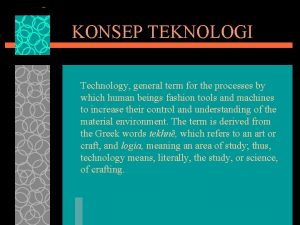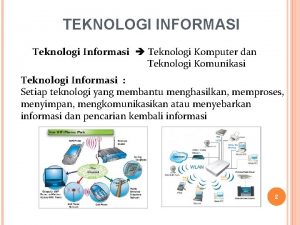KONSEP TEKNOLOGI Technology general term for the processes















- Slides: 15

KONSEP TEKNOLOGI Technology, general term for the processes by which human beings fashion tools and machines to increase their control and understanding of the material environment. The term is derived from the Greek words tekhnē, which refers to an art or craft, and logia, meaning an area of study; thus, technology means, literally, the study, or science, of crafting.

Technology has been a dialectical and cumulative process at the center of human experience. It is perhaps best understood in a historical context that traces the evolution of early humans from a period of very simple tools to the complex, large-scale networks that influence most of contemporary human life. For the sake of simplicity, the following account focuses primarily on developments in the Western world, but major contributions from other cultures are also indicated.


The earliest known human artifacts are roughly flaked stones used for chopping and scraping, found primarily in eastern Africa. Known as Oldowan tools, they date from about 2. 3 million years before present, and serve to define the beginning of the Stone Age.

By about 40, 000 years before present, humans had begun to use fire and to make a variety of tools, including pear-shaped axes, scrapers, knives, and other instruments of stone, bone, and other materials. They had also begun to use tools to make clothing and build shelters for protection from inclement weather. The use of tools can be observed in many members of the animal kingdom, but the capacity for creating tools to craft other objects distinguishes humans from all other animals.

The next big step in the history of technology was the control of fire. By striking flint against pyrites to produce sparks, people could kindle fires at will, thereby freeing themselves from the necessity of perpetuating fires obtained from natural sources. Besides the obvious benefits of light and heat, fire was also used to bake clay pots, producing heat-resistant vessels that were then used for cooking grains and for brewing and fermenting.

Ancient Agricultural Practices Relief art on the walls of the tomb of Nefer Sakkara shows Egyptian workers harvesting crops and tending livestock with rudimentary tools.

Early Agricultural Tools Humans began farming about 12, 000 years ago. The ability to control their food supply freed people from a nomadic lifestyle, which allowed for the beginning of cities and towns. These early farming tools date from about 6, 000 bc. The picture portrays an axe (bottom) used for clearing; flint sickles (left), used for harvesting cereal crops; a flat rock and rounded stone (center), used for grinding flour; and perforated clay slabs (upper right), probably used to ventilate bread ovens

To assist the efficient transportation of minerals for the growing copper-working industry, two-wheeled carts were constructed; the oldest wheels yet found date from about 3500 bc, in Mesopotamia.

Aerial view of Central Athens Symmetry and geometric design played an important role in city planning in ancient Greece and Rome. City planners designed distinct residential, marketing, recreation, and religious areas and interspersed them evenly throughout the city. Streets often followed a gridiron pattern as developed by Hippodamus, the father of city planning. Many cities were surrounded by high fortification walls. Hippodamus’ gridiron pattern of city blocks remains a legacy in many Greek cities, as shown in this photograph of modern Athens, Greece. .

Step Pyramid, Şaqqārah The Step Pyramid of King Djoser was built during the 3 rd Dynasty at Şaqqārah, Egypt. It was designed by the architect Imhotep. The pyramid was the first monumental royal tomb and is one of the oldest stone structures in Egypt.

The first cities were also, in effect, war machines, built within walls for defense and organized for battle and conquest. Urban centers at Ur, Nippur, Uruk, Thebes, Heliopolis, Assur, Nineveh, and Babylon were arsenals of destructive weaponry. The goal of a military force was to lay waste the city of its enemy. Ur, in Sumer, was not only one of the first great cities to arise (about 4000 bc) but also one of the first to be destroyed (about 2000 bc).

Catapult The catapult worked like a giant slingshot, propelling large stones, javelins, and other objects over high walls, moats, and other barriers during ancient times and the Middle Ages. One type of catapult called the mangonel used the torsion of heavy cords twisted between two uprights to throw heavy stones, but it had little accuracy.

Ancient Roman Aqueduct, Spain One of the best-preserved ruins of the Roman Empire, this aqueduct, named El Puente (Spanish for “The Bridge”), stretches from Spain’s Frío River to the city of Segovia. Built during the rule of Roman Emperor Trajan in the 1 st century ad, the aqueduct runs both above and below the ground and stretches for a total of 16 km (10 mi). These two tiers of arches, at the center of an aboveground portion of the aqueduct, reach a height of 28. 5 m (93. 5 ft).

Automation Trade-Off Technological advancement has both positive and ill effects on a society. Take, for example, advances in automation technology. Automation has improved production efficiency and quality control, and has reduced the need to have workers perform potentially dangerous tasks. On the other hand, automation has made many jobs unnecessary, putting employees out of work, or forcing them to retrain.
 Konsep teknologi
Konsep teknologi Concurrent processes are processes that
Concurrent processes are processes that Hsc multiple choice generator
Hsc multiple choice generator Maksud techne
Maksud techne Konsep pengajaran dan pembelajaran teknologi digital
Konsep pengajaran dan pembelajaran teknologi digital Konsep teknologi informasi
Konsep teknologi informasi Definisi teknologi pengajaran
Definisi teknologi pengajaran Pengertian konsep teknologi
Pengertian konsep teknologi Konsep integrasi ilmu pengetahuan teknologi dan seni
Konsep integrasi ilmu pengetahuan teknologi dan seni Konsep dasar teknologi informasi
Konsep dasar teknologi informasi Fspos vägledning för kontinuitetshantering
Fspos vägledning för kontinuitetshantering Typiska novell drag
Typiska novell drag Tack för att ni lyssnade bild
Tack för att ni lyssnade bild Ekologiskt fotavtryck
Ekologiskt fotavtryck Varför kallas perioden 1918-1939 för mellankrigstiden?
Varför kallas perioden 1918-1939 för mellankrigstiden? En lathund för arbete med kontinuitetshantering
En lathund för arbete med kontinuitetshantering




























